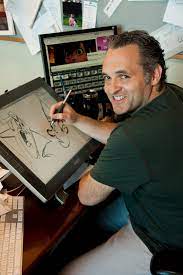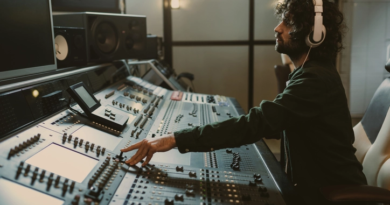What is Animator Director?How Do You Become An Animator Director?
An animation director is a creative professional who oversees the artistic and technical aspects of creating an animated production, whether it’s a feature film, TV show, video game, or other forms of animated content. The animation director plays a key role in bringing the vision of the production to life by leading a team of animators, artists, and technicians.
The role of an animation director can vary depending on the type of project they’re working on, but their primary responsibility is to ensure that the animation is of high quality, visually appealing, and consistent with the project’s overall artistic vision. The animation director works closely with the production team to plan, develop, and execute the animation process from start to finish.

In general, an animation director’s duties can be divided into four main categories: pre-production, production, post-production, and team management. Let’s take a closer look at each of these categories.
Pre-production: During pre-production, the animation director is responsible for conceptualizing the visual style and tone of the production. This involves working with the creative team to develop the script, storyboard, and character designs. The animation director must ensure that the visual style is consistent with the overall vision of the project and that the characters are well-designed and fully realized. The animation director must also develop a plan for the production timeline, budget, and resource allocation.
Production: During production, the animation director works closely with the animators and artists to ensure that the animation is of high quality and consistent with the established style and tone of the production. The animation director is responsible for reviewing the animation and providing feedback and guidance to the team. They may also be responsible for overseeing the technical aspects of the animation process, such as the use of software and hardware, and ensuring that the animation is completed within the established timeline and budget.
Post-production: After the animation is complete, the animation director oversees the post-production process, which includes editing, sound design, and visual effects. They ensure that the final product is of high quality and consistent with the project’s overall vision.
Team management: The animation director is responsible for managing the team of animators, artists, and technicians who work on the production. This involves providing leadership, guidance, and motivation to the team, as well as resolving any conflicts that may arise. The animation director must also ensure that the team is working efficiently and effectively, and that each member is contributing their skills and expertise to the project.
In addition to these core responsibilities, an animation director may also be involved in other aspects of the production, such as marketing and promotion, script revisions, and casting.

To be successful as an animation director, one must have a strong background in animation and art, as well as excellent communication, leadership, and organizational skills. They must also be able to work effectively with a team of creative professionals and manage a complex production process.
There are several key skills and qualities that are essential for an animation director, including:
- Artistic talent: An animation director must have a strong artistic ability and a deep understanding of the principles of animation, including movement, timing, and composition. They must also have a good eye for color, design, and visual storytelling.
- Technical skills: An animation director must be proficient in the use of animation software and hardware, such as Autodesk Maya, Adobe After Effects, and Toon Boom Harmony. They must also be knowledgeable about the technical aspects of animation production, such as rendering, compositing, and lighting.
- Leadership: An animation director must be a strong leader who can motivate and inspire a team of creative professionals. They must be able to delegate tasks effectively, provide feedback and guidance, and resolve conflicts in a constructive manner.
- Communication: An animation director must have excellent communication skills, both verbal and written.
How Do You Become An Animator Director?
Becoming an animation director is a long and challenging journey that requires a combination of artistic talent, technical skills, and leadership abilities. Here are some steps that you can take to become an animation director:
Step 1: Develop Your Artistic Skills
The first step in becoming an animation director is to develop your artistic skills. This involves studying the principles of animation, such as timing, movement, and composition. You should also practice drawing and sketching, as well as experimenting with different styles and techniques.

You can develop your artistic skills by attending art school or taking online courses. Some popular programs for aspiring animators include the California Institute of the Arts, Ringling College of Art and Design, and Savannah College of Art and Design.
Step 2: Learn Animation Software and Techniques
In addition to artistic skills, animation directors must also be proficient in the use of animation software and techniques. This includes software such as Autodesk Maya, Adobe After Effects, and Toon Boom Harmony, as well as techniques such as rigging, compositing, and rendering.
You can learn animation software and techniques by taking online courses, attending workshops and seminars, or practicing on your own. It’s important to stay up-to-date with the latest trends and technologies in the animation industry, as this will give you a competitive edge when applying for jobs.
Step 3: Gain Experience in the Animation Industry

To become an animation director, you need to gain experience working in the animation industry. This involves starting at the bottom and working your way up the ranks, gaining experience and building your portfolio along the way.
An animation director is a creative professional who oversees the artistic and technical aspects of creating an animated production, whether it’s a feature film, TV show, video game, or other forms of animated content. The animation director plays a key role in bringing the vision of the production to life by leading a team of animators, artists, and technicians.
The role of an animation director can vary depending on the type of project they’re working on, but their primary responsibility is to ensure that the animation is of high quality, visually appealing, and consistent with the project’s overall artistic vision. The animation director works closely with the production team to plan, develop, and execute the animation process from start to finish.

In general, an animation director’s duties can be divided into four main categories: pre-production, production, post-production, and team management. Let’s take a closer look at each of these categories.
Pre-production: During pre-production, the animation director is responsible for conceptualizing the visual style and tone of the production. This involves working with the creative team to develop the script, storyboard, and character designs. The animation director must ensure that the visual style is consistent with the overall vision of the project and that the characters are well-designed and fully realized. The animation director must also develop a plan for the production timeline, budget, and resource allocation.
Production: During production, the animation director works closely with the animators and artists to ensure that the animation is of high quality and consistent with the established style and tone of the production. The animation director is responsible for reviewing the animation and providing feedback and guidance to the team. They may also be responsible for overseeing the technical aspects of the animation process, such as the use of software and hardware, and ensuring that the animation is completed within the established timeline and budget.
Post-production: After the animation is complete, the animation director oversees the post-production process, which includes editing, sound design, and visual effects. They ensure that the final product is of high quality and consistent with the project’s overall vision.
Team management: The animation director is responsible for managing the team of animators, artists, and technicians who work on the production. This involves providing leadership, guidance, and motivation to the team, as well as resolving any conflicts that may arise. The animation director must also ensure that the team is working efficiently and effectively, and that each member is contributing their skills and expertise to the project.
In addition to these core responsibilities, an animation director may also be involved in other aspects of the production, such as marketing and promotion, script revisions, and casting.

To be successful as an animation director, one must have a strong background in animation and art, as well as excellent communication, leadership, and organizational skills. They must also be able to work effectively with a team of creative professionals and manage a complex production process.
There are several key skills and qualities that are essential for an animation director, including:
- Artistic talent: An animation director must have a strong artistic ability and a deep understanding of the principles of animation, including movement, timing, and composition. They must also have a good eye for color, design, and visual storytelling.
- Technical skills: An animation director must be proficient in the use of animation software and hardware, such as Autodesk Maya, Adobe After Effects, and Toon Boom Harmony. They must also be knowledgeable about the technical aspects of animation production, such as rendering, compositing, and lighting.
- Leadership: An animation director must be a strong leader who can motivate and inspire a team of creative professionals. They must be able to delegate tasks effectively, provide feedback and guidance, and resolve conflicts in a constructive manner.
- Communication: An animation director must have excellent communication skills, both verbal and written.
How Do You Become An Animator Director?
Becoming an animation director is a long and challenging journey that requires a combination of artistic talent, technical skills, and leadership abilities. Here are some steps that you can take to become an animation director:
Step 1: Develop Your Artistic Skills
The first step in becoming an animation director is to develop your artistic skills. This involves studying the principles of animation, such as timing, movement, and composition. You should also practice drawing and sketching, as well as experimenting with different styles and techniques.

You can develop your artistic skills by attending art school or taking online courses. Some popular programs for aspiring animators include the California Institute of the Arts, Ringling College of Art and Design, and Savannah College of Art and Design.
Step 2: Learn Animation Software and Techniques
In addition to artistic skills, animation directors must also be proficient in the use of animation software and techniques. This includes software such as Autodesk Maya, Adobe After Effects, and Toon Boom Harmony, as well as techniques such as rigging, compositing, and rendering.
You can learn animation software and techniques by taking online courses, attending workshops and seminars, or practicing on your own. It’s important to stay up-to-date with the latest trends and technologies in the animation industry, as this will give you a competitive edge when applying for jobs.
Step 3: Gain Experience in the Animation Industry

To become an animation director, you need to gain experience working in the animation industry. This involves starting at the bottom and working your way up the ranks, gaining experience and building your portfolio along the way.







